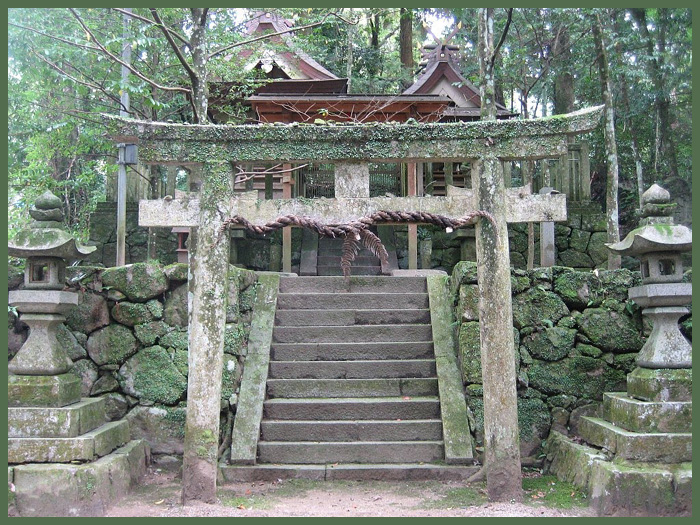. Japanese legends and tales 伝説 民話 昔話 - Introduction .
::::::::::::::::::::::::::::::::::::::::::::::::::::::::::::::::::::::::::::::::::::::::::::::::::::::::::::::::::::::::::::::::::::::::::::::::::::::::::::::::::::::::::::::
matagi 又鬼 - マタギ と伝説 Legends about bear hunters
mata oni ni naru 又鬼 "I have to become a demon again" . . . matagi . . .
The matagi hunter only takes life when it is absolutely necessary to support his life and the forest. He apologizes to the forest for taking life, prays for the soul of the dead animal and gives thanks to the circle of mountain life.
Many Matagi live in Ani town in Akita. 秋田県阿仁
. matagi 又鬼 - マタギ bear hunters .
- Introduction -

マタギ奇談 - 狩人たちの奇妙な語り
工藤隆雄 Eto Takao
..............................................................................................................................................

越後三面山人記 - マタギの自然観に習う
田口洋美 Taguchi Hiromi
日本の狩猟文化研究の第一人者、東北芸術工科大学教授兼狩猟文化研究所所長・田口洋美氏の若き日の意欲作、隠れたロングセラーを文庫化。
朝日連峰の山懐、新潟県の三面川(みおもてがわ)中流の深い谷間にあった三面集落。
今は三面ダムの底に沈んだこの山里の狩猟文化・山村習俗を、四季折々の山の民の暮らしを追うかたちで詳細に記録した、著者若き日の意欲作。
第一章 狩りの日の出来事
第二章 降りしきる雪の中で-冬-
第三章 山の鼓動とともに-春-
第四章 むせるような緑に抱かれて-夏-
第五章 時雨れる雲ノ下で-秋-
第六章 山人の自然学
::::::::::::::::::::::::::::::::::::::::::::::::::::::::::::::::::::::::::::::::::::::::::::::::::::::::::::::::::::::::::::::::::::::::::::::::::::::::::::::::::::::::::::::
- - - - - ABC List of the prefectures :
.......................................................................... Akita 秋田県 ......................................
. Yama no Kami 山の神 God of the Mountain - Akita .
In Akita there are many bear-hunter communities.
On the festival day of the female Yamanokami, who is very jealous, their womenfolk do not dare to go outside all day.
.......................................................................
kodama nezumi コダマ鼠 / 小玉鼠 Kodama Nezumi Yokai monster - Little Ball Rat

source : twitter.com/meirojp/status
It is feared by the Matagi of Akita, especially in Ani. Some say it evolved from seven Matagi who died the same day during a hunting accident.
If the rat hears the sound of a gun, it will rush to the spot and interfere with the hunting. When it spots a human, it stops what it's doing, inflates like a balloon, explodes and splatters the hunter with its own blood and guts.
If the hunters become aware of one, the Matagi will retreat from the mountain as fast as they can.
- reference : kodama nezumi yokai -
.......................................................................
Once upon a time in winter
a group of seven young Matagi went to the mountain forest. At night it begun to snow. On the second morning a young woman came to their hut and asked to be allowed to take shelter. On that night, the woman sucked the soul out of six of them and killed them. The last one woke up in time, took his hatched and chased the monster away.
.......................................................................
kakesu カケス / 橿鳥 / 懸巣 jay, Garrulus glandarius
If the jay make a racket, it will certainly rain. The Matagi pay attention to them.
.......................................................................
北秋田郡 阿仁町 Ani
Once their was a Matagi family wanting for food. Just then Kobo Daishi passed their hut and they wanted to take away his robes. He tried to understand their plight and told them, "Even if you now repent,
mata oni ni naru - you will become Oni again!
Hunting is your job, so go ahead and do it."
This is the origin of their name.
.
Yamagami no sakabu 山神のサカブ(叫び)は細く硬い声で、遠いところで響く鉦の音に似ている。女の声にも似ているが少し違う。明治30何年かに、この声で7尺5寸もある大きな熊を発見して捕ったことがあったという。
.......................................................................
鹿角郡 Katsuno district 小坂町 Kosaka town
iwana 岩魚 fish of the Salvelinus family
昔柴内という村の八郎 Hachiro というマタギが、仲間と共に奥瀬山に入った時、雪溶け水に泳ぐ岩魚を救って食べた。するとあんまり喉が渇き、持っていたワッパで飲んでも間に合わず、腹ばいして鯨飲しているうちにその身が蛇身と化し、遂に十和田湖へ飛び込んで主となったという。
.......................................................................
仙北郡 Senboku district 角館町 Kakunodate
If the mice are disappearing from a Matagi's mountain hut, they know that something is amiss and disaster looming.
- - - - -
Once a young Matagi let a monkey caught in a trap run free.
Next day the monkey and his monkey friends brought 苺や栗 strawberries and chestnuts to show their gratitude.
- - - - -
Once a Matagi was caught in an avalanche and burried in snow. BUT some villagers had seen a young man carrying a pole on his shoulder coming down from the mountain. This must have been his ghost.
So now nobody dares to go to the mountain carrying a pole on the shoulder.
- - - - -
Once a wife took some lunch to her father working in the mountain. But the female Yamanokami became jealous and when the father cut a tree, he fell below it and died.
.......................................................................
山本郡 Yamamoto district 藤里町 Fujisato town
When the Matagi are out hunting, a youngster stays in the hut to take care of cooking.
Sometimes a yamabito (sanjin) 山人 "mountani man" comes. The weather usually tunrs bad soon after that.
::::::::::::::::::::::::::::::::::::::::::::::::::::::::::::::::::::::::::::::::::::::::::::::::::::::::::::::::::::::::::::::::::::::::::::::::::::::::::::::::::::::::::::::

bears and hunters enjoying a break
野間仁根色紙 painting by Noma Hitone
::::::::::::::::::::::::::::::::::::::::::::::::::::::::::::::::::::::::::::::::::::::::::::::::::::::::::::::::::::::::::::::::::::::::::::::::::::::::::::::::::::::::::::::
.......................................................................... Miyagi 宮城県 ......................................
... matagi no kinki マタギの禁忌 taboos for bear hunters ...
If the wife of a hunter had given birth, her husband should not go to the mountain for 27 days, because Yamanokami dislikes 穢れ unclean things.
Others say they had to stay out of the mountain forest until the seventh night was over.
If a hunter would go anyway, he did not find any animal to shoot. Others would loose their way and not come home.
Another hunter was found having committed suicide in the forest . . . and more strange tales are told.
.......................................................................
マタギの家では寒三十日の間は決して豆を煎らない。豆を煎ったとき豆の跳ねる音がすると、その響きで山に雪崩が起きるという。また、節分の日に豆を煎り、その豆を食べて山へ出かけると災難に遭わず、その豆を山に持参すると災厄を除くという。
.......................................................................
yamanokami 山ノ神 likes Okoze stone fish
If the Matagi bear hunters do not find an animal, the leader takes a piece of Okoze wrapped in white ritual paper out of his pocket and offers it to Yamanokami.
And - oh wonder - they soon find their pray.
. okoze 虎魚 / 鰧魚 / オコゼ / ヲコゼ stonefish .
.......................................................................
仙台市 Sendai 太白区 Taihaku
. The brothers 万二万三郎 Banji and Banzaburo and the matagi マタギ hunters of Nikko. .
24 more legends from Miyagi
::::::::::::::::::::::::::::::::::::::::::::::::::::::::::::::::::::::::::::::::::::::::::::::::::::::::::::::::::::::::::::::::::::::::::::::::::::::::::::::::::::::::::::::
- reference : nichibun yokai database 妖怪データベース -
マタギ 49 to explore (02)
Akita 12 0K

Nametoko yama no kuma なめとこ山の熊 The bears of Nametoko Mountain
宮沢賢治 Miyazawa Kenji
..............................................................................................................................................
. Legends about Kobo Daishi Kukai - 弘法大師 空海 - 伝説 .
. Japanese legends and tales 伝説 民話 昔話 - Introduction .
- Yookai 妖怪 Yokai Monsters of Japan -
- Introduction -
::::::::::::::::::::::::::::::::::::::::::::::::::::::::::::::::::::::::::::::::::::::::::::::::::::::::::::::::::::::::::::::::::::::::::::::::::::::::::::::::::::::::::::::

. Join the friends on Facebook ! .
- #matagi #bearhunter -
::::::::::::::::::::::::::::::::::::::::::::::::::::::::::::::::::::::::::::::::::::::::::::::::::::::::::::::::::::::::::::::::::::::::::::::::::::::::::::::::::::::::::::::
[ . BACK to DARUMA MUSEUM TOP . ]
[ . BACK to WORLDKIGO . TOP . ]
::::::::::::::::::::::::::::::::::::::::::::::::::::::::::::::::::::::::::::::::::::::::::::::::::::::::::::::::::::::::::::::::::::::::::::::::::::::::::::::::::::::::::::::








































